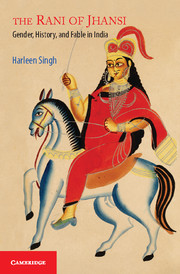Book contents
- Frontmatter
- Dedication
- Contents
- List of Figures
- Acknowledgements
- I Introduction
- II Enslaving Masculinity: Rape Scripts and the Erotics of Power
- III India's Aryan Queen: Colonial Ambivalence and Race in the Mutiny
- IV Coherent Pasts in Hindi Literature and Film
- V Unmaking the Nationalist Archive: Gender and Dalit Historiography
- Afterword
- Bibliography
- Index
Afterword
Published online by Cambridge University Press: 05 July 2014
- Frontmatter
- Dedication
- Contents
- List of Figures
- Acknowledgements
- I Introduction
- II Enslaving Masculinity: Rape Scripts and the Erotics of Power
- III India's Aryan Queen: Colonial Ambivalence and Race in the Mutiny
- IV Coherent Pasts in Hindi Literature and Film
- V Unmaking the Nationalist Archive: Gender and Dalit Historiography
- Afterword
- Bibliography
- Index
Summary
There's always more to tell even when the story has ended.
Mahasweta DeviI was six years old when I first heard of Rani Lakshmi Bai. The national and at that time only television channel Doordarshan had broadcast Sohrab Modi's Hindi film Jhansi Ki Rani to mark 15 August, India's Independence Day. The next day found me in The English Book Shop, one of the two bookstores in my city, where I eagerly bought and read the Amar Chitra Katha comic Rani of Jhansi. However, these early experiences in Hindi film and English reading were not my initiation into historical or literary research about this heroic queen from India's past. It took a particularly severe scolding from my teacher in class eight to do that. I was admonished for getting into a fight with boys and told to check myself or, as the teacher said, ‘Who do you think you are, the Rani of Jhansi?’
Rani Lakshmi Bai, the Queen of Jhansi, remains metonymic in the nation's imagination. She symbolises India's enduring spirit and martyred past and the communicative significance of the Rani is borne out by the plethora of representation around her. Her mutability as a subject of racial, sexual, linguistic, religious and caste-based representation places her where the intersections of culture and literature cannot be simply accounted for within the historical diachronic.
- Type
- Chapter
- Information
- The Rani of JhansiGender, History, and Fable in India, pp. 163 - 168Publisher: Cambridge University PressPrint publication year: 2014



